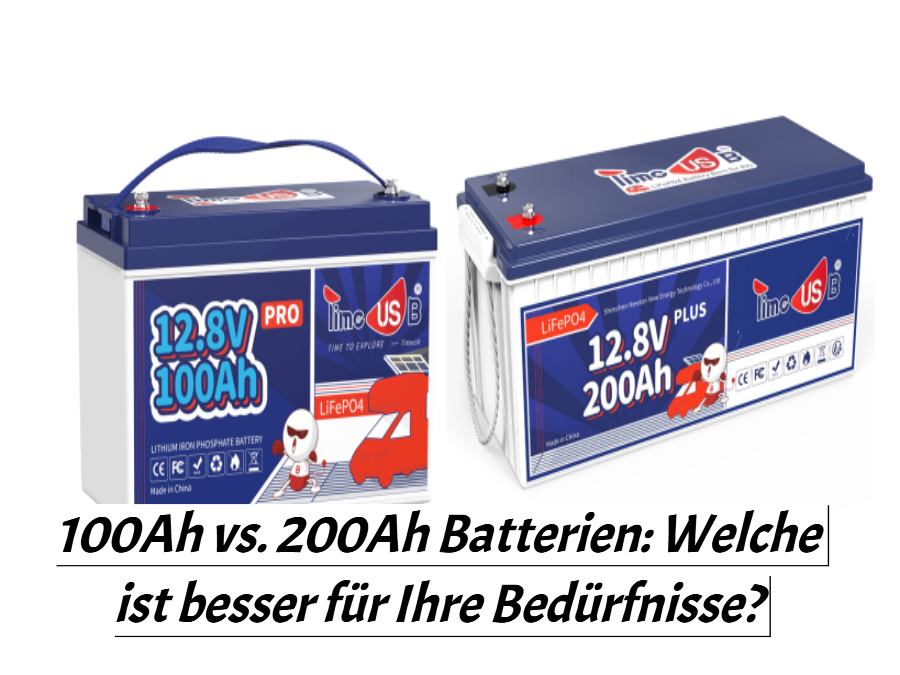What are LiFePO4 batteries & why are they the best?

Lithium-ion batteries are a much newer innovation that has become increasingly popular in recent years as they have proven their value in powering small and large electronic devices. Among these, the LiFePO4 lithium batteries have come out on top as they are not only safer but also offer many advantages over other lithium batteries, especially for high-power applications. In this article, we discuss the pros and cons of common lithium batteries and explore why LiFePO4 lithium batteries are the best.
What is the LifePO4 battery?
LiFePO4 battery refers to a lithium-ion battery that uses lithium iron phosphate as the positive electrode material. The main advantages are high rated current and long cycle life, as well as good thermal stability, increased safety and tolerance to abuse.
This is the name of the lithium batteries
In the industry, we usually use the positive electrode material to name the battery. The negative electrode is generally made of graphite. The lithium cobalt oxide battery uses lithium cobalt oxide as the positive electrode material. Similarly, lithium iron phosphate batteries use lithium iron phosphate material for positive electrodes.
Advantages and disadvantages of other lithium batteries
There are different types of lithium batteries available on the market today. The most common types include:
▲Lithium cobalt oxide batteries (LiCoO2)▲
Advantages:
- High energy density, which means they can store a lot of energy in a small space.
- Low self-discharge, which allows them to hold their charge for a long time.
- Long service life with an average of 300-500 charging cycles.
Disadvantages:
- Due to the use of cobalt, a rare and expensive material, production is expensive.
- Limited capacity for fast charging, which can lead to overheating and shortened lifespan.
- If handled improperly, there is a risk of thermal runaway and fire.
▲Lithium manganese oxide batteries (LiMn2O4)▲
Advantages:
- Low cost due to the use of manganese, a more common and less expensive material than cobalt.
- Good safety profile with low risk of thermal runaway and fire.
- High power output, making them suitable for high performance applications.
Disadvantages:
- Lower energy density than LiCoO2 batteries, which means they have less capacity to store energy.
- Higher self-discharge rate than LiCoO2 batteries, meaning they may need to be charged more frequently.
- Shorter lifespan than LiCoO2 batteries with an average of 200-300 charging cycles.
▲Lithium nickel manganese cobalt oxide batteries (LiNiMnCoO2)▲
Advantages:
- High energy density, which means they can store a lot of energy in a small space.
- Good balance between performance and energy density, making them suitable for both high power and high capacity applications.
- More cost-effective than LiCoO2 batteries due to the use of nickel and manganese.
Disadvantages:
- Shorter lifespan than LiCoO2 batteries, with an average of 200-300 charging cycles.
- If handled improperly, there is a risk of thermal runaway and fire.
- Limited capacity for fast charging, which can lead to overheating and shortened lifespan.
▲Lithium-ion batteries (Li-Ion)▲
Li-ion batteries are the most common type of lithium battery used in consumer electronics. They have a high energy density, meaning they can store a lot of energy in a small space. Li-ion batteries are also known for their long lifespan, meaning they can be charged and used many times before needing to be replaced.
Advantages:
- High energy density
- Long service life
- Low self-discharge rate
- Light and compact
- No memory effect
Disadvantages:
- Expensive to produce
- Susceptible to thermal runaway (risk of explosion or fire if handled improperly)
- Sensitive to high temperatures
- The capacity decreases over time
▲Lithium polymer batteries (LiPo)▲
LiPo batteries are similar to Li-ion batteries, but have higher energy density and can be manufactured in different shapes and sizes. They are commonly used in drones, remote-controlled toys, and other small electronic devices.
Advantages:
- High energy density
- Light and compact
- Can be made in different shapes and sizes
- Low self-discharge rate
- No memory effect
Disadvantages:
- More expensive than Li-ion batteries
- Prone to swelling and bulging
- Sensitive to high temperatures
- The capacity decreases over time
▲Lithium titanate (LTO) batteries▲
LTO batteries are a newer type of lithium battery with high power density and fast charging capability. They are widely used in electric vehicles, power tools and renewable energy systems.
Advantages:
- fast charging functions
- High power density
- Long lifespan
- Stable at high temperatures
Disadvantages:
- Lower energy density than Li-ion batteries
- More expensive than Li-ion batteries
How LiFePO4 batteries are developing
Phosphate was first discovered in 1996 at the University of Texas as a cathode material for rechargeable lithium batteries. When scientists discovered that cathode materials were better alternatives for lithium-ion batteries because they offered good electrochemical performance with low resistance. High current rating, increased thermal stability, increased safety, environmental friendliness and long cycle life - all possible advantages and LiFePO4 lithium batteries are born.
Nowadays we can see LiFePO4 lithium batteries charging everywhere, especially in portable and stationary devices that require high load currents and endurance: RVs, trolling motors, bass boats, car stereos, home solar systems, golf carts, electric motorcycles, vehicles and more/off-grid applications.
LiFePO4 batteries cost less over time than most of their alternatives because they have longer cycle times to ensure longer lifespans, and they shape a very promising future for the lithium battery industry.
But what makes the LiFePO4 lithium battery a better choice?
⭐Longer lifespan⭐
One of the biggest advantages of LifePO4 batteries is their long cycle life. A cycle is defined as one charge and one discharge cycle, and the number of cycles a battery can handle before its performance degrades is called its cycle life. LifePO4 batteries have a much longer cycle life than other lithium batteries, with some models managing up to 2000 cycles.
This means that a LifePO4 battery can be charged and discharged more often before it needs to be replaced, making it a more cost-effective option in the long run.
⭐Safer and more stable⭐
Another advantage of LifePO4 batteries is their safety and stability. Because they use an iron phosphate cathode, they are less susceptible to thermal runaway, which can cause other lithium batteries to catch fire or explode. This makes them a safer option for applications such as electric vehicles and residential energy storage.
⭐Higher discharge rate⭐
LifePO4 batteries also have a higher discharge rate than other lithium batteries, meaning they can deliver more power in a shorter period of time. This makes them ideal for applications such as power tools and electric vehicles where high performance is required.
⭐Better performance at low temperatures⭐
LifePO4 batteries work better at low temperatures than other lithium batteries because they have a higher energy density and lower internal resistance, which means they can maintain their performance even in cold temperatures.
Applications of LifePO4 batteries
LifePO4 batteries are used in a wide range of applications, from portable electronics to electric vehicles and renewable energy systems. The most common applications include:
⭐electric vehicles⭐
LifePO4 batteries are an ideal choice for electric vehicles due to their high energy density, long lifespan and safety. They are also more environmentally friendly than other lithium batteries, which can contain toxic substances such as cobalt.
⭐home energy storage⭐
LifePO4 batteries are also used for home energy storage, where they can store excess energy generated by solar panels or wind turbines. They are a cost-effective and reliable option for off-grid and on-grid systems.
⭐Portable Electronics⭐
LifePO4 batteries are commonly used in portable electronics such as smartphones and laptops, where they are a popular choice due to their high energy density and long lifespan.
How long do LiFePO4 batteries last?
The lifespan of a LiFePO4 lithium battery depends on several factors, including usage, charge and discharge cycles, temperature and storage conditions. In general, LiFePO4 batteries have a longer lifespan compared to other battery types, such as Li-ion batteries or lead-acid batteries.
LiFePO4 batteries are typically designed for a lifespan of 2,000 to 5,000 cycles, depending on the battery model and usage conditions. It is known that Timeusb LiFePO4 batteries up to 4,000 cycles at 100% DOD, 6,000 cycles at 80% DOD and 15,000 cycles at 60% DOD.
In addition to cycle life, operating temperature can also affect the lifespan of a LiFePO4 battery. Operating the battery at higher temperatures than recommended can shorten its lifespan. Storing the battery in hot or humid environments can also affect its lifespan.
It is also important to note that the capacity of a LiFePO4 battery can degrade over time, even when not in use or charged. The rate of deterioration depends on storage conditions and the specific battery model.
Conclusion
In conclusion, LifePO4 batteries have proven to be a better option in many ways compared to other lithium batteries. Due to their improved safety, higher capacity, longer lifespan and more consistent performance, they are becoming increasingly popular in a wide range of applications, from electric vehicles to renewable energy systems. Even though they are a bit more expensive, their many benefits make them a worthwhile investment in the long run. So, if you are looking for a lithium battery, consider choosing a LifePO4 battery for a more reliable and sustainable energy solution.




